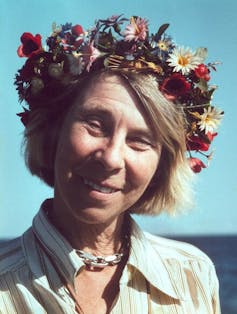Detta inlägg post publicerades ursprungligen på denna sida this site ;
Date:
Author: Sue Walsh, Lecturer, Department of English Literature, University of Reading
Original article: https://theconversation.com/tove-janssons-moomin-books-explore-the-power-of-adventure-and-transformation-245969
This year marks the 80th anniversary of the first Moomin tale, The Moomins and the Great Flood. In the book, Moomintroll and his friends embark on a journey to find their home after a great flood devastates Moominvalley, meeting odd creatures and new friends along their journey.
The book was first published in creator Tove Jansson’s native Swedish in 1945. However, the first Moomin book to have an English edition was in fact the third of the Moomin books, Trollkarlens Hatt (The Hobgoblin’s Hat). It was translated by Jansson’s friend Elizabeth Portch and reached its widest English-speaking audience when it was published by Puffin Books in 1961 as Finn Family Moomintroll.
At the beginning of the story Moomintroll finds a magical top hat. It can transform anything that is placed inside of it into something else entirely – and so the adventures begin.
This is part of a series of articles celebrating the 80th anniversary of the Moomins. Want to celebrate their birthday with us? Join The Conversation and a group of experts on May 23 in Bradford for a screening of Moomins on the Riviera and a discussion of the refugee experience in Tove Jansson’s work. Click here for more information and tickets.
Unlike the Swedish-language edition, Portch’s translation of Finn Family Moomintroll begins with a letter from Moominmamma. It’s written in a curly cursive and dotted with love-hearts and an image of an apparently “hand-drawn” troll. The letter is addressed to a “dear child” who is “overseas”.
In it, Moominmamma expresses disbelief at the idea that there may not be any Moomins “there over” and that the child she is addressing may “not even know what a troll is” (hence the illustration).
Moominmamma’s wonder at the differences in custom between her own land and “your country” is based on an assumption that the two must be somewhat alike. Similarly, her explanation of what Moomintrolls are depends on their difference from the “usual common trolls”, which means there must be familial similarity between them.
Both Moominmamma’s wonder at and explanation of difference assume an underlying essential similarity or sameness between Moominvalley, where she lives, and the reader’s home. This is significant in a story that explores ideas of foreignness and translation, change and transformation.
Though the adventures in Finn Family Moomintroll might be said to only truly begin on the spring morning when Moomintroll, Sniff and Snufkin find “a tall black hat”, the book opens with the Moomins settling down for their winter hibernation and closes with the valley in autumn.

Per Olov Jansson/Wiki Commons, CC BY-SA
The changes wrought by the Hobgoblin’s hat are “quite different” because “you never know beforehand” what they will be. However, their extreme nature is framed and contained by a world in which there are known and predictable changes in the seasons, as well as routine – though sometimes dramatic – changes in the weather.
The Hemulen is unperturbed by the hat’s transformation of eggshells into fluffy little clouds that Moomintroll and his friends are able to ride. That’s because he is “so used to [them] doing extraordinary things”. But when Moomintroll is transformed by the hat into “a very strange animal indeed”, so much so that his friends do not recognise him, it’s a very different matter.
A moment of real jeopardy occurs when Moomintroll’s own mother does not seem to recognise him either. But this is soon dispelled when Moominmamma looks “into his frightened eyes for a very long time” and quietly declares: “Yes, you are my Moomintroll.”
This moment of recognition breaks the spell and Moomintroll changes back into “his old self again”. One of the crucial features of the hat is the changes it makes are only temporary and this, together with Moominmamma’s reassurance that she will “always know [Moomintroll], whatever happens”, suggests an ultimately unchanging essence to things that cannot be denied.
Changelessness as deadening
On the other hand, the book suggests that some change is to be embraced.
Sniff’s desire for things to stay the same “for ever and ever” is portrayed as immature and wrong-headed. As is the Muskrat’s obsessive quest for peace and stillness which ends up with his apparent, though temporary, transformation into a monster.
Snufkin’s point that “life is not peaceful” offers a gentle rebuke to the Hemulen, who also wishes to “live his life in peace and quiet”. But perhaps the clearest indication of the book’s attitude to changelessness is the monstrous Groke. She is motivated by an unwavering drive to recover the “King’s Ruby”, not because this thing which “changes colour all the time” is “the most beautiful thing in the world”, but because it is “the most expensive”.
The Groke’s inability to appreciate the ruby aesthetically is presented as being rooted in her own immutability. That the Groke’s hostility to change is itself deadening, becomes evident when she sits “motionless” before the Moomins and their friends, staring at them in a way that makes them feel “she would wait for ever” and eventually departs leaving the ground behind her frozen in the wrong season.
This, then, is key. Adventure, transformation and change in Finn Family Moomintroll are both necessary and desirable, but they are also contained within a reassuring frame of reliable predictability. The final lines of the English translation are: “It is autumn in Moomin Valley, for how else can spring come back again?”
![]()
Sue Walsh does not work for, consult, own shares in or receive funding from any company or organisation that would benefit from this article, and has disclosed no relevant affiliations beyond their academic appointment.

